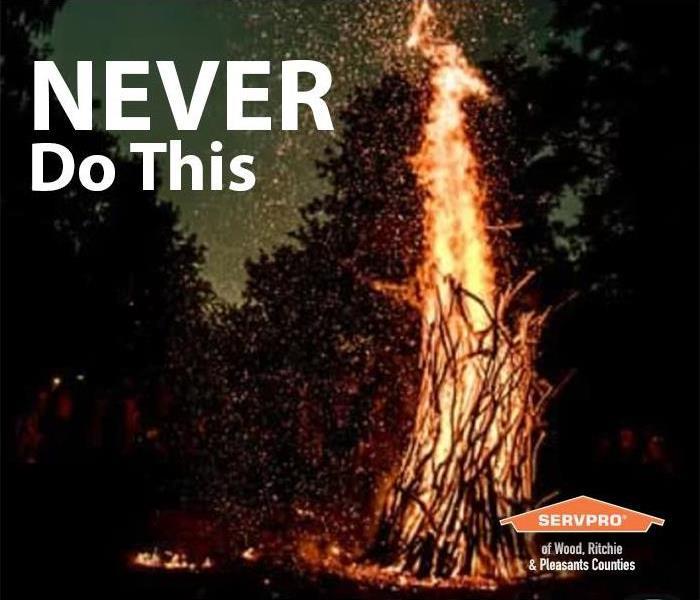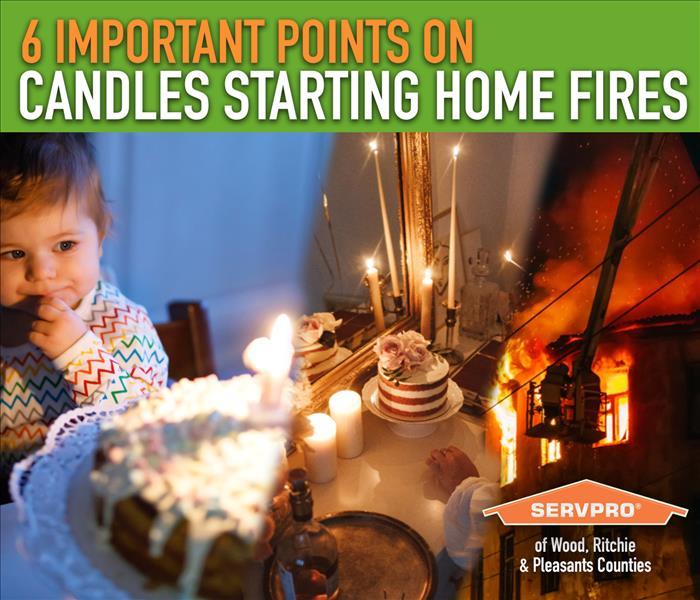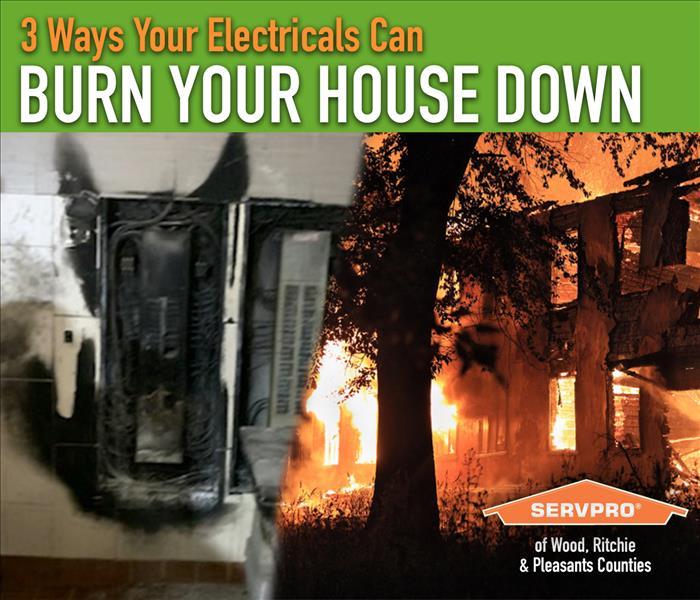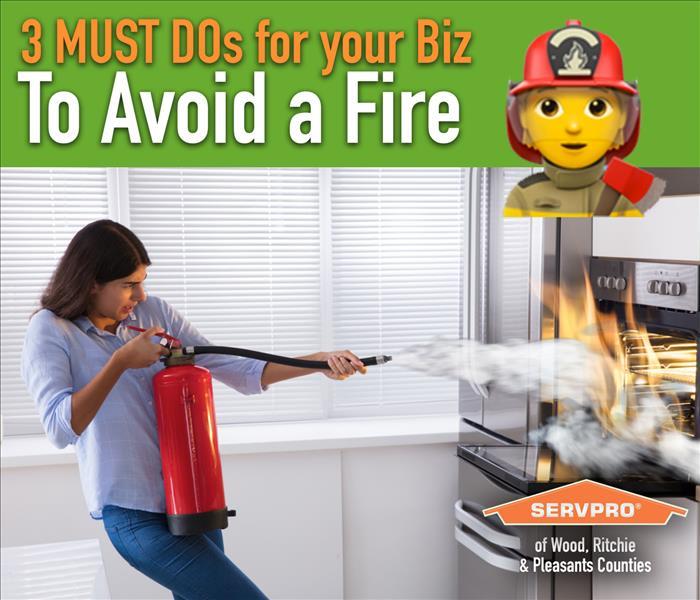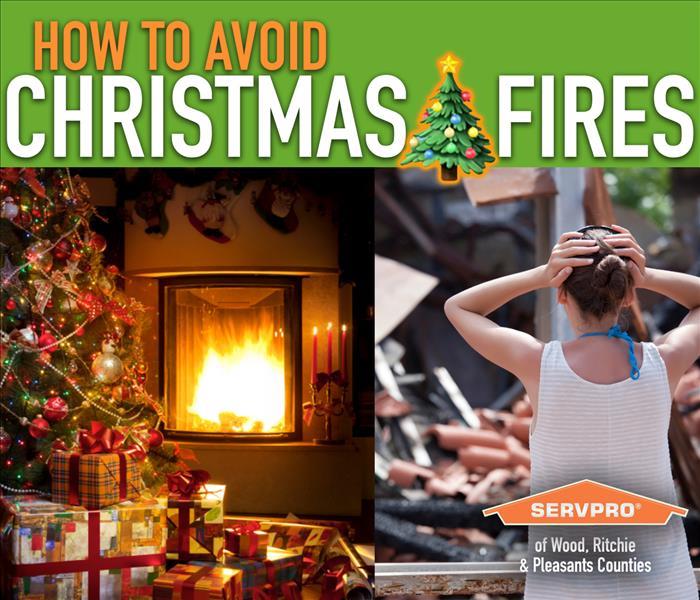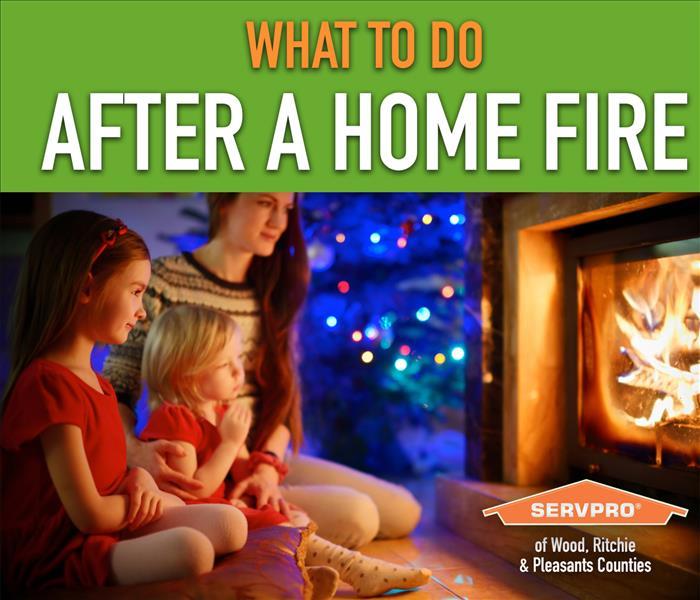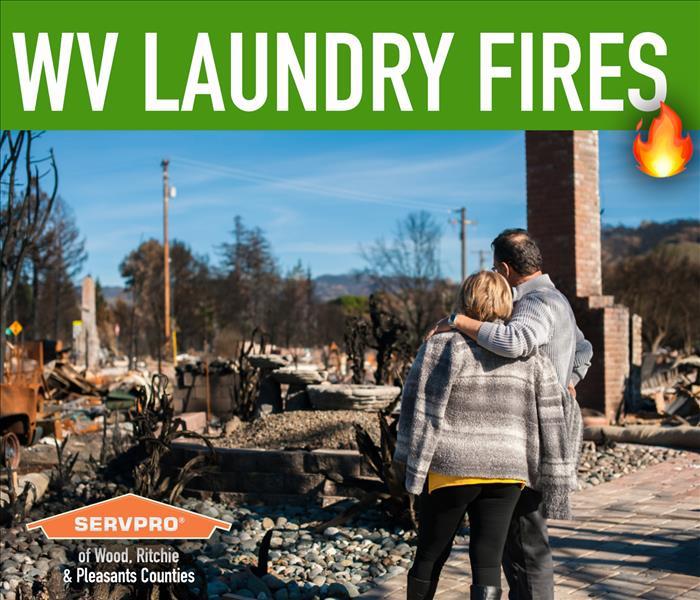Recent Fire Damage Posts
Never do this at a bonfire
10/29/2024 (Permalink)
 Never do this at a bonfire
Never do this at a bonfire
Bonfires are one of our favorite Fall pass times, where we create great memories with our friends and family. But there are some very important safety precautions to take to be sure you don’t burn anything down.
What to do When Building a Bonfire (and avoid headaches)
- Let your neighbors know you’re having one because you don’t want them to complain (it’s just not worth it).
- Use dry materials for the bonfire, using damp materials will create more smoke, which will annoy you and your neighbors.
- Build your bonfire at least 5 times it’s height away from other fixtures such as the house, sheds, fences and trees, with a minimum of 10 feet.
- Keep away from telephone wires and cables
4 Things to NEVER Do with Your Bonfire
- Never leave the bonfire unattended
- Never throw any fireworks into the fire
- Never use petrol or paraffin to get the fire going as it may get out of control quickly
- Never burn aerosols, tires, canisters or anything containing foam or paint - many produce toxic fumes and some containers may explode, causing injury
2 Very Important Safety Precautions
- Keep a fire extinguisher or hose and faucet within 20 feet of the fire
- When the bonfire has died down, spray the embers with water to stop it reigniting.
5 Tips to avoid Fires in the Fall
9/6/2022 (Permalink)
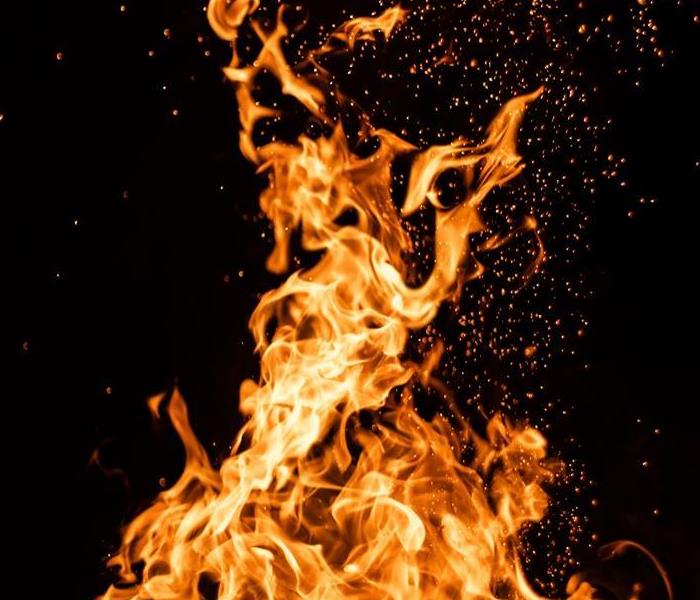 Fire Coming from the Ground.
Fire Coming from the Ground.
1.Be sure you are at least 25 feet away from structures or anything else that can burn before building a fire. Choose an open, level location and clear away any dry leaves and sticks, overhanging branches and shrubs.
2.Never use gasoline, kerosene or any other flammable liquid to start a fire. Instead, use a match or lighter to ignite tinder (small twigs and dry leaves); add larger sticks and pieces of dry wood.
3.Keep the fire small and controlled, and never leave it unattended.
4.Do not stand too close to the fire or play around it, and do not attempt to jump over it. Keep an eye on children and pets so they don’t get too close to the flames either.
5.Check that any decorative lights have been tested for safety. Examine each set of lights for broken sockets, frayed wires or loose connections, and discard any damaged sets. Be careful not to overload sockets when plugging in lights and other electronic decorations.
4 Tips to avoid Fires during Halloween
9/6/2022 (Permalink)
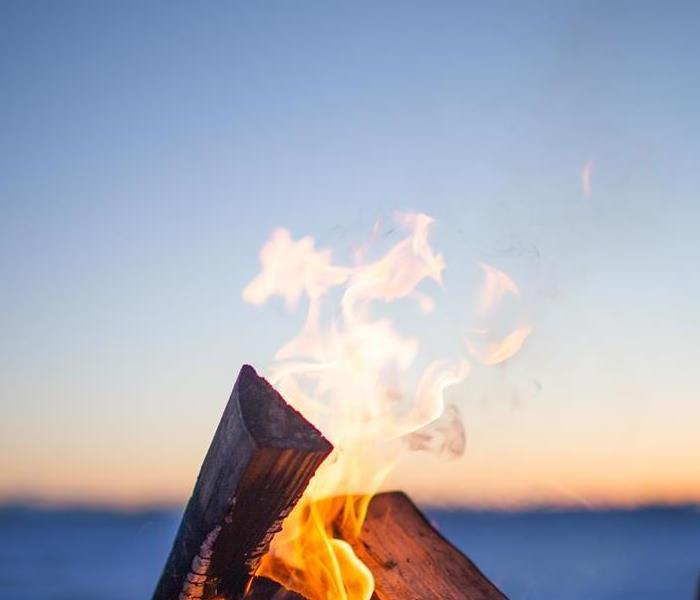 Small Fire with 3 pieces of wood.
Small Fire with 3 pieces of wood.
1. Consider glow sticks or battery-operated candles instead of real candles when lighting your jack-o’-lanterns or other luminaries. If you do use real candles, light them with long, fireplace-style matches or a utility lighter. Keep lit decorations off of doorsteps, yards and sidewalks where excited trick-or-treaters may knock them over.
2. Check that no decorations are blocking your home’s exits or pathways, so you have a clear escape route in case of an emergency.
3. Avoid costumes with loose, trailing fabrics or other hanging parts, which can catch fire on open flames. Check the labels on costumes, wigs and props to be sure they are made with flame resistant or retardant materials.
4. Practice the “stop, drop and roll” technique. “This is a great time of the year for adults to teach children about fire safety, as well as first aid measures if someone gets hurt,” Hultman says.
Leading Causes of House Fires & How to Avoid Them
9/6/2022 (Permalink)
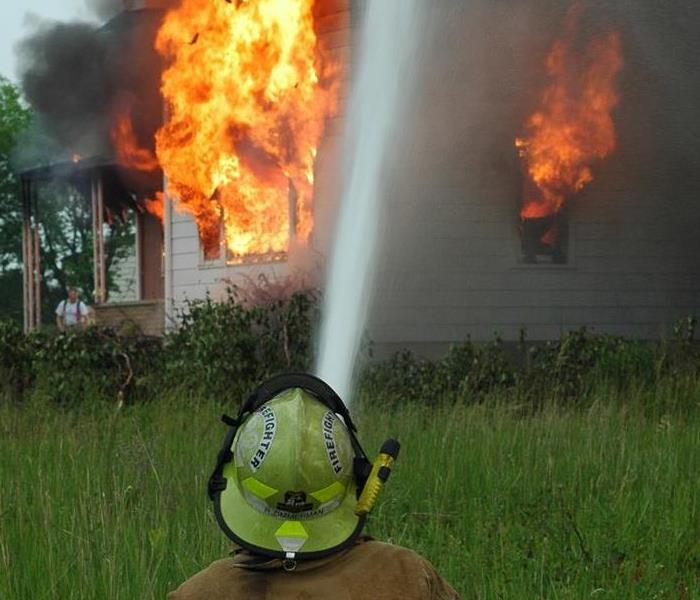 A House fire being put out.
A House fire being put out.
1. Electrical systems and equipment
- Have your home inspected by a qualified electrician, especially when purchasing an older home.
- Use a qualified electrician when having electrical work done.
- Watch for the warning signs of faulty wiring. These can include blown fuses, visibly damaged wiring, discoloration around outlets, flickering lights or burning odors.
- Protect your home against arc faults. An arc fault occurs when an electrical short produces an arc: intensely hot sparks that can set fire to nearby flammable materials. Arcs often happen in appliance or extension cords that have become frayed or cracked.
- To prevent arc faults, have Arc Fault Circuit Interrupters (AFCIs) installed in your home. These devices look and work like conventional circuit breakers. When an AFCI detects an arc, it shuts off the circuit.
- Power surges can damage appliances and even cause fires. Protect your home with a two-tiered surge protection system: a whole house surge protection device (SPD) on the main electrical service to the home, and point-of-use SPDs for all valuable electronics and appliances.
- Smart sensor devices can help detect the invisible dangers lurking in your home.
2. Heating equipment
- Consider replacing older space heaters with new ones that turn off automatically when overheated or tipped. Keep them at least three feet away from anything flammable.
- Have furnaces and chimneys professionally cleaned and inspected every year.
- All fireplaces should have a sturdy screen. Never use flammable liquids to start a fire in a fireplace. Allow ashes to cool completely and use a metal bucket for disposal.
3. Cooking fires
- Be alert. If you are sleepy or have consumed alcohol, don't use the oven or stove.
- Stay in the kitchen while you are frying, grilling or broiling food. If you need to leave the kitchen for even a short period of time, turn off the oven or stove.
- If you are simmering, baking, roasting or boiling food, check it regularly. Remain in the home while food is cooking, and use a timer to remind you that you are cooking.
- Keep your stovetop clear of anything that can catch fire, including oven mitts, wooden utensils, food packaging, towels or curtains.
Maintaining your Smoke Detectors
3/9/2022 (Permalink)
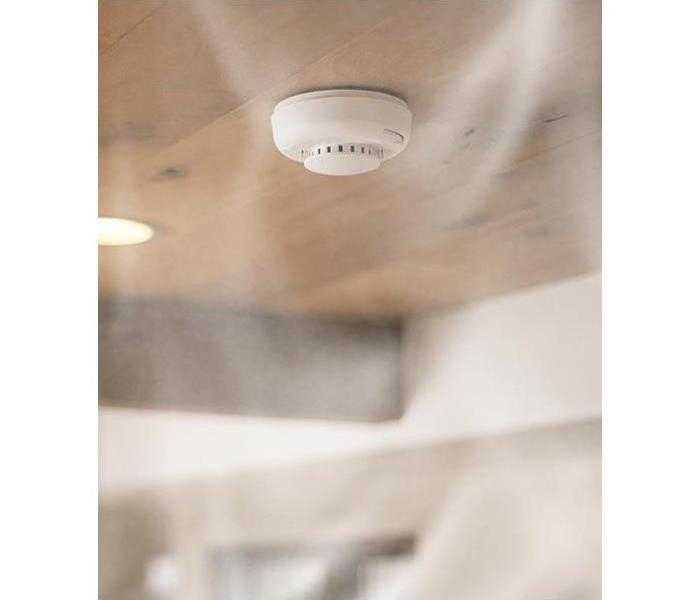
Smoke Detectors are incredible devices, and they are designed to help keep you and your family are safe. That being said, it is extremely important that your alarms are correctly installed and are tested on a regular basis. Making sure your alarms are installed correctly is vital. But even beyond installation, you will want to be sure that you are maintaining your alarms. Depending on the detectors that you choose, the maintenance can differ.
1. Nine-Volt Battery Powered Detectors
As an affordable smoke detector, nine-volt powered detectors require monthly inspections and tests, you should make sure that the alarm is clean and doesn’t have any debris on it, by pressing the test button, that will allow you to test the alarm. You should also replace the batteries annually to be sure the alarm is functioning correctly. It’s also recommended that every 10 years you replace the alarms.
2. Long-Life Alarms
These smoke detectors require a 10-year lithium battery. As these batteries should not need to be replaced, it is recommended that the entire unit be replaced according to the manufacturer’s instructions. But, you should still test the alarm and make sure it is free of debris at least once a month.
3. Hardwired Fire Signals
Hardwired fire signals are wired directly into your home's electrical system, which adds a sense of security because the units communicate with each other, sounding alarms throughout the home. This type of alarm is replaced every 10 years and tested monthly. The battery backup should be also replaced every year.
A smoke detector can provide reassurance because it will alert you and therefore protect you and your home. However, depending on the type of alarm, each detector requires a certain amount of upkeep to maintain its intended performance.
Christmas Fire Dangers to Your Home ** and how to avoid them in 2021 **
11/29/2021 (Permalink)
Christmas is meant to be a time shared with your loved ones. A positive time filled with laughs, not tears (unless they're crying with laughter).
But something so small and simple can grow into destruction.
Fires.
And in this festive time, there are so many fire hazards that are out and about in your home that are not around the rest of the year.
Here are three common Christmas fire triggers in your home.
3 Common Areas Christmas Fires Start
- The Christmas tree the lights on the trees can heat up and cause a fire in the home.
- Fireplace decorations being so close to fire, they can be a hazard for catching on fire.
- Candle Flames they are so beautiful, but we easily forget about them, and this creates a problem waiting to happen.
So what can I do without Ruining the Joy of Christmas?
- The Christmas Tree ornaments Make a habit of checking all your electrical decorations and lights before turning them on for the first time. After sitting in storage for 11 months a lot of decay and/or damage can happen, making them a risk to short circuiting or sparking.
- The Fireplace decorations - keep all items at least 4 feet (ideally 6ft) away from the fire place.
- Candle Flames - if possible avoid using candles with open flames. Either use cover flames or even electronic candles (some of them now look so real!). If you really cannot avoid open flames (or any flames for that matter) then never leave a room unattended if a candle is lit.
By covering just these simple steps you will dramatically reduce the risk of home fires (big and small) and ensure that you will really enjoy this Christmas.
Keep safe and enjoy this beautiful time with your loved ones.
Merry Christmas from the Team at SERVPRO of Wood, Ritchie & Pleasants Counties.
Fire Prevention
10/12/2021 (Permalink)
October:Fire Prevention Month
October is National Fire Prevention Month. At SERVPRO of Wood, Ritchie, and Pleasants Counties, we wanted to remind everyone to practice their fire escape plans and test their smoke alarms in order to prevent house fires. We also wanted to remind you of some simple things you can do to lower your risk of a fire:
- Test your smoke detector regularly. The easiest way to avoid a fire is by checking your smoke alarms. Press the little button to test it. If the beep is weak, change the batteries as soon as possible.
- Inspect your heating sources. If your heating sources are not working right, they can trigger a fire. Your heat source needs to be in a place that is away from anything that is flammable. Make sure you clean your heating source regularly to keep dirt and debris from catching fire
- Clean your stove and oven. Cleaning your oven and stove can prevent food particles from getting too hot and causing a fire.
- Don’t Leave the Kitchen when you’re cooking. It takes just a few seconds for a fire to start. If you have to leave your kitchen, make sure to turn off your burner first.
- Check your Dryer. Make sure you clean your lint trap every time you do a new load of laundry. Inspecting your dryer on a yearly basis is great as well.
- Check your cords. Before plugging something in, make sure your wires aren’t damaged. If they are, replace them. This can be a huge fire hazard. Check where you are running your cords as well, running them under a rug or between your wall and your furniture can be a bad idea, because cords tend to get hot.
- Use Candles Cautiously. Who doesn’t love a good, scented candle? Especially in the fall. Make sure putting them out before leaving a room. If you feel like you’re about to go to sleep, make sure the candle is out. Keep them out of reach of pets and children. Placing them on a hard even surface. Keeping them away from any objects can prevent a possible fire as well.
- Store flammable objects properly. Hairspray, cleaning products, and even shaving cream can be as hazard if they are exposed to a lot of heat, they can combust. Store them in a cool area.
- Keep a Fire extinguisher handy. Fire extinguishers are your best friend when a fire starts. Be sure to have one definitely in the kitchen. Make sure each family member knows where it is and how to use it, so if a fire does happen, it can be put out as quickly as it started.
- Use caution with your fireplace. Make sure you have a door between your fire and your floor. Never leave the room when a fire is going. When you put your fire out make sure your ashes are cool before throwing them out. Also, throw them away in a metal container that is specifically just for the fireplace ashes.
House fires are most often caused by cooking and heating equipment risks, which increase during this time of the year. This month is a great time for families to prepare themselves before the most high-risk time of year for fires, and fire emergencies. Preventing and preparing could save your life and your home. Having an escape plan in place and practicing it, is just as important as doing all the things listed above! Be sure to prepare and stay safe this holiday season!
4 Things to NEVER Do with a Bonfire this Fall
9/7/2021 (Permalink)
Bonfires are one of our favorite Fall pass times, where we create great memories with our friends and family. But there are some very important safety precautions to take to be sure you don’t burn anything down.
What to do When Building a Bonfire (and avoid headaches)
- Let your neighbors know you’re having one because you don’t want them to complain (it’s just not worth it).
- Use dry materials for the bonfire, using damp materials will create more smoke, which will annoy you and your neighbors.
- Build your bonfire at least 5 times it’s height away from other fixtures such as the house, sheds, fences and trees, with a minimum of 10 feet.
- Keep away from telephone wires and cables
4 Things to NEVER Do with Your Bonfire
- Never leave the bonfire unattended
- Never throw any fireworks into the fire
- Never use petrol or paraffin to get the fire going as it may get out of control quickly
- Never burn aerosols, tires, canisters or anything containing foam or paint - many produce toxic fumes and some containers may explode, causing injury
2 Very Important Safety Precautions
- Keep a fire extinguisher or hose and faucet within 20 feet of the fire
- When the bonfire has died down, spray the embers with water to stop it reigniting.
6 Important Points to Know About Candle Fires in Homes in West Virginia
3/29/2021 (Permalink)
Home fires are often caused by the smallest, and most beautiful looking items in our homes. A simple scented (or non-scented) candle can turn your home from beauty to burned down in a matter of minutes.
Candles serve their purpose and it’s important that if you enjoy them, keep using them, but please practice safety whenever using candles.
To give you (and the community) a bigger understanding of the dangers National Fire Protection Association (www.nfpa.org) here are 6 important points you know should know to understand how common it is. Hopefully this will motivate more safety in our community.
During the five-year period of 2014-2018:
- Candles caused 2% of reported home fires, 3% of home fire deaths, 6% of home fire injuries, and 4% of the direct property damage in home fires.
- Roughly one-third (37%) of home candle fires started in bedrooms. These fires caused 40% of the associated deaths and 49% of the associated injuries.
- Falling asleep was a factor in 10% percent of the home candle fires and 15% of the associated deaths.
- On average, 21 home candle fires were reported per day.
- Three of every five (60%) of home candle fires occurred when some form of combustible material was left or came too close to the candle.
- December is the peak time of year for home candle fires. In December, 12% of home candle fires began with decorations compared to 4% the rest of the year.
A burned down home or business is not only traumatic, it’s also a very slow, long and expensive process to get your life back to normal again. Please be careful, and follow the safety measures.
If you would like more information on fire safety we have a lot of great resources that you can read though by clicking here.
If you have any more questions please call SERVPRO of Wood, Ritchie & Pleasants Counties on 304-428-7378
3 Ways Your Electricals Can Burn Down Your House (and how to avoid it)
3/23/2021 (Permalink)
Electrical Fires are common problems in the family home (and in businesses). Their damage can range from small to catastrophe.
At SERVPRO, we've seen family homes severely damaged from easily avoidable electrical issues. We urge you to read this closely, but more importantly follow the steps. A few minutes every few months could save your home or business going up in flames.
What Are The Leading Causes of Electrical Fires?
1. A lack of air flow: Electrical equipment and wires heat up. Obvious? Yep! But we commonly have multiple wires sitting together, without the ability to cool down. Just like this person in Parkersburg! [Click here to view]
2. Overloading the Circuit. Have you ever seen (or even have) a power board with piles of cords plugged into it? Sometimes these can get so crazy that it looks like a game of Pick up Sticks. Each cable added to the power board exponentially increases the risk of short-circuiting happening, which can spark and cause a fire.
3. Damaged Wires: Damaged wires are a fire waiting to happen. Similar to having an overloaded circuit, a damaged wire has a dramatically increased risk of creating a spark and therefore creating a fire.
How to Avoid these Risks in under 5 minutes.
Make sure to routinely check your power outlets and wires. It will take you less than a few minutes to do the entire home (or business).
- Check your wires have enough space: Resolving this issue will be the longest to fix of the three. This issue may require professional help such as from an electrician. But before you "put this on the back burner" have another look at what happened to a home in Parkersburg (who were lucky). [Click here to view]
- Check your Power Outlets: As a general rule, if your power boards have 3 sockets, only use the 3. Do not add additional adapters into the sockets.
- Replace all damaged wires: Wires are thankfully affordable to replace these days. So if there's a cable that's damaged, throw it out and buy a new one. If it requires special attention we recommend calling your local electrician for help. Remember, a few dollars to get someone to fix it is cheaper than a burned out room in your home!
We hope this has helped. To read through 3 Ways Your Kitchen Can Burn Your House Down (and How to Avoid It) click here.
If you ever need any questions answered, or need help with fire, mold, storm or water damage, please call your local team at SERVPRO on 304-428-7378 or contact us on our contact page.
From the team at SERVPRO of Wood, Ritchie & Pleasants Counties.
3 Ways Your Kitchen Can Burn Your House Down (and How to Avoid It)
3/8/2021 (Permalink)
Home fires in Wood County and surrounding areas can cost families $10,000 to well over $100,000, and in 90% of occurrences, they are easily avoidable.
After 3 years in the local area we have noticed that there are 3 common causes of home fires. Knowing them is important so that you can avoid having this heartbreaking event happen to you. And here is the first of the 3:
Your Cooking Equipment
Cooking fires are placed as the number one cause of home fires in the United States, according to the National Fire Protection Association. This is consistent with what we’ve seen in the local area.
Best Practices to Keep Your Home and Family Safe
Never walk away from the stove / kitchen top.
In a matter of minutes (sometimes even less) pots and pans can overheat, catching something nearby on fire, which can quickly escalate to a much larger fire.
DO NOT have any Flammable items within 3 feet of your stove, toaster or any other items that cook.
This is a matter of minimising risk. If something is to catch fire by accident, if something is close, it adds to the fire and allows it to spread (or jump) to the next item. So keep all flammable items including towels more than 3 feet away so that if a fire starts it cannot spread.
NEVER throw water onto burning oil or grease.
We cannot stress how dangerous this is. By throwing water onto your burning oil you’re creating a bomb. The water initially goes below the oil / grease, but heats up fast, turning to gas, which then tries to quickly escape above the oil / grease, causing the oil/grease to explode. This will likely burn your face and body, and also jump onto other flammable items. Do this instead: turn off the stove. Let it cool down on its own.
We hope this helped. If you have any further questions or would like some tips, please do not hesitate to call us on 304-428-7378 or email us on this page —> click here.
From the team at SERVPRO of Wood, Ritchie & Pleasants Counties
Read More:
3 Ways Your Electricals Can Burn Down Your House (and how to avoid it)
3 Must-Do Steps in Your Business to Potentially Avoid a Devastating Fire
2/13/2021 (Permalink)
Do you have a concrete fire safety protocol in your business? Do you have a routine Fire Extinguisher check? This simple act, could potentially save $10,000 to $100,000+ in damages. A small fire (which could be stopped from a fire extinguisher) can very quickly grow through your entire business in a matter of minutes.
If you already haven’t, make this safety protocol (which takes merely minutes once you’ve set it up) part of your policy immediately.
- Have a fire extinguisher safely mounted to the wall in every major room.
- Make sure that every staff member knows where they are located.
- Create a fire marshal responsibility to one of your staff who are responsible for:
- Knowing the fire extinguisher’s expiries
- Having them replaced before they expire
- Making sure that the staff are all knowledgeable of how to operate the fire extinguishers.
- For more information on fire extinguishers visit keystonefire.com
How to Safely Operate Your Fire Extinguisher in an Emergency
Remember the Acronym - P.A.S.S.
P - Pull the Pin on the fire extinguisher
A - Aim the nozzle or hose at the base of the fire. Keep a safe distance away.
S - Squeeze the handle to release the extinguishing materials
S - Sweep the nozzle from side to side.
Continue directing the foam at the base of the fire until it is completely extinguished.
Please, if you haven’t got a policy and procedure already in place, we cannot stress enough to make sure that you revisit what we’re saying in this article and implement it immediately. It could save you a lot of money and heartache.
If you have any further questions, please do not hesitate to ask our team for information by calling 304-428-7378 or contact us by clicking here.
Hope this has helped,
The team at SERVPRO of Wood, Ritchie & Pleasants Counties
3 Christmas Fire Dangers That Could Burn Your Christmas Cheers (and how to avoid them)
12/15/2020 (Permalink)
It’s meant to be the most wonderful time of the year but do you know how to keep it that way and avoid dangerous fires? You may not want to think of “what could go wrong”, but let’s prepare on how to avoid it, to ensure safety this Christmas.
Lucky for you, it only takes a few simple steps to keep your house and family safe during the festive season. When you finish this article, you’ll feel confident and safe celebrating Christmas at home.
3 Festive Dangers & How To Avoid Them
- Christmas Light Fires - Christmas lights bring families joy every year, but these festive decorations can often spark fires. Before lighting up your house and tree, be mindful to check each bulb individually and ensure they are not damaged. Also check for exposed wires inside and outside, because when they get wet, they could create a deadly spark on your Christmas tree.
- Fireplace Decorations - Stockings upon the fireplace can turn your home into a Winter Wonderland. Would you know what to do if they caught fire? We don’t often consider the dangers of such a beautiful decoration, but they can quickly help a flame escape the fireplace. When decorating, keep a safe distance between your stockings and the fireplace. If possible, avoid decorating the top and sides. This will give you peace of mind when trying to keep warm at Christmas.
- Candle Flames - Candles are responsible for hundreds of fires each Christmas. Getting caught up in Christmas festivities might mean we leave candles burning during the night, or place flammable items next to them. To reduce the risk of fire make sure there are no lit candles in your home before you go to bed, or in easy to reach places. Something as simple as keeping candles off coffee or dining tables could stop a fire from starting.
Read our related articles and make sure you’re prepared for the worst case scenario. Not only will you save thousands in repairs, but you could save family and friends from deadly flames.
If you have any further questions please call us on 304 428 7378 or click here to contact us.
The Team at SERVPRO of Wood, Ritchie & Pleasants Counties.
Related Articles:
How To Save Your Pets From Fires
Save Money After A House Fire
5 Actions For Fire Damage to Save Money and Headaches
11/30/2020 (Permalink)
Article at a glance:
- What to do and what not to do after a fire
- How you can save thousands on restoration before help arrives
Fires in our homes and businesses are enough to make anyone panic. This is why it’s crucial to know the basic steps to take after a blaze ignites. Not only will you keep everyone safe, but it could save you thousands on your restoration bill.
5 Actions To Take Before Help Arrives
- Limit Movement - Avoid using damaged carpet and upholstery until it is professionally cleaned. Walking through your home can result in further embedding of soot into the carpet, which makes it more expensive to remove, or may even require complete removal and replacement of your carpet.
- Protect High Traffic Areas - Place old towels or linen over high traffic areas e.g. lounges, carpeted stairs and walkways. This will save you money on cleaning, as well as stopping the spread of stains and marks throughout your property.
- Switch Off Electricity - Switching off your electrical appliances will reduce the risk of a fire reigniting. Circuits are often damaged during fires, and making sure they’re turned off may mean your appliance can be repaired. WARNING: In some cases damaged electricals can mean danger to bystanders such as yourself. Make sure to survey the electricals before touching. If you’re unsure do not attempt to turn anything off. Your health and safety are more important.
- Check Ceilings For Moisture - It is common that our ceilings become damp after a fire. Turn off any ceiling fixtures and locate the damp spots. With damaged wires, and wet ceilings, it is likely that a fire will spark again if things aren’t properly checked.
- Move Your Belongings - If any of your belongings remain untouched by the fire, ensure you move them to a clean space immediately. This will avoid any further damage from smoke, and reduce the chance of them becoming covered in soot during the cleaning process.
By taking these simple actions, you will be able to save thousands on your restoration bill. Don’t wait for help to arrive to save your property and belongings!
We hope that this has helped and you have found value. If you have any further questions regarding professional water removal and water damage restoration please call us on 304 428 7378 or click here to contact us.
The Team at SERVPRO of Wood, Ritchie & Pleasants Counties.
Read Further:
How To Avoid Laundry Fires
Keep Your Pets Safe From Fires
DO THIS to Keep Your Pets Safe Before & After Fires
10/12/2020 (Permalink)
 Their life is our responsibility
Their life is our responsibility
Article at a glance:
- 3 precautions to take before a fire starts
- 3 Steps to take after a fire starts that will save your pets
Fires start and spread quickly, especially with the flammable items that fill our homes. Do you want to be caught in a fire, unprepared? Take a close read of the points below. Go over them a few times because your pet's life may be at stake.
3 Precautions To Take Before A Fire
- Ensure your pet's bed isn’t near any items that are highly flammable. Household items like curtains or chemicals are dangerously fast to go up in flames. Keep your pet's bed(s) near easily escapable areas, such as the front or back doors (we know this might sound crazy in day to day).
- Place a leash near the front door. When a fire breaks out in your home every second is crucial. By placing their leash near the door you will know exactly where to go in the frantic moments. This saves more confusion when you’re outside, trying to keep your pets close to you.
- Train your pet(s) with basic (but vital) commands. It’s vitally important that your pet knows basic commands like “come”. This simple but effective step will also save time when leaving the house. It may also help you avoid having to search for your pet.
3 Simple Steps To Take After The Fire
- Place your pet on a leash. Not only will this help them feel secure, but pets commonly try and escape when they feel stressed. Having them on a leash will reduce the risk of them running away, or getting injured outside the house.
- Give your pet water. It’s likely your pet will become hot and dehydrated after being around a fire. Make sure they have access to drinking water once you have left the house. This will help stop them from becoming overheated.
- Make sure your pet is okay. Look and feel for any burns or injuries. It is recommended that you take your pet to a local vet for a general health assessment as soon as possible.
We hope that this has helped and you have found value. If you have any further questions please call us on 304 428 7378 or click here to contact us.
The Team at SERVPRO of Wood, Ritchie & Pleasants Counties.
Related Articles:
Silent Water Damage - 3 Things You Need to Know
Crawlspace Waterproofing - How It Can Help You Avoid $10,000+ in Damages
3 Ways Home Fires Start in the Laundry Room (and how to Avoid them)
7/27/2020 (Permalink)
While rare, laundry room fires have effected numerous families in Parkersburg, WV over the past years. These fires may start small but within minutes laundry fires can grow and take over the entire house, taking away all your possessions. No family deserves this. Let’s look at what you can do to minimize (and hopefully neutralize) the chance of this ever happening in your home.
3 Ways Fires Start In The Laundry
- Blocked Filters and Vents: Over time, the vents and filters of the dryer may get blocked. The heat inside the dryer does not get released as there is no way out. In this way, the temperature may cause the lint to catch fire.
- Leaving Moist Clothes in the Hot Dryer: Clothes such as towels or bed sheets, etc. may take longer to get dry. After washing the clothes, leaving these damp items inside the dryer is very risky. The dryer is hot, so leaving the clothes inside for too long can start a fire in the laundry.
- Washing Fabrics at Higher Temperatures: All fabrics cannot be washed at high temperatures. Normally people wash all of their fabrics at the same temperature and this can lead to problems. It is important to note that some fabrics, especially cotton fabrics, need to be washed at relevantly lower temperatures than others. We advise keeping an eye on the temperature while washing different types of clothes together.
How to Avoid Fire Damage:
Here is how you can avoid a laundry fire starting regarding the three points above:
- Blocked Filters and Vents: Check the filters after every wash. Most dryers have a very easy method of cleaning out the filters. By making it common practice (it literally takes seconds!) you are dramatically minimizing the chances of fire damage occurring.
- Leaving Moist Clothes in the Hot Dryer: After each wash empty it fully. This might sound silly but even leaving a sock in there may create a chance of issues arising.
- Washing Fabrics at Higher Temperatures: Look at the guidelines on the tag of the clothing you are washing. If they are suggesting a cold wash, please do this!
Bonus note: Only use the dryer when you are at home. Never use the clothes dryer when you are out of home, even if you are quickly running to the store.
Preventions are always better than a cure. By following the instructions mentioned above, you can easily avoid the possibility of laundry fire.
In the horrible event any fires start please call 911 immediately.
We hope this has helped,
The Team at SERVPRO of Wood, Ritchie & Pleasants Counties - Fire Damage Restoration Services.
3 Common Ways Kitchen Fires Start, and how to Avoid Them in West Virginia
7/7/2020 (Permalink)
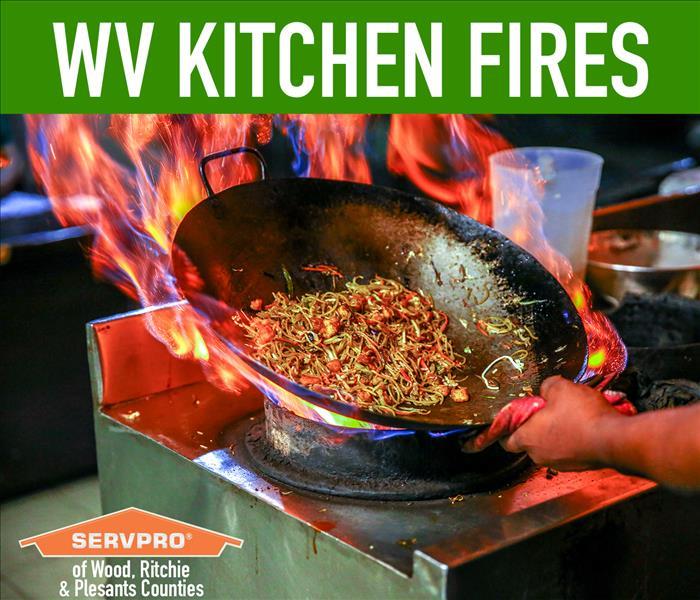 Kitchen Fires Happen Often, Please be Prepared
Kitchen Fires Happen Often, Please be Prepared
Fire damages everything that comes in its way, from tall buildings to small living rooms. The tendency of specific things to catch fire may increase or decrease, depending on the situation and the availability of fire-causing elements. These elements include heat, oxygen, and fuel, and they are mostly present in kitchens, making kitchens more vulnerable to catch fire in West Virginia.
How Kitchen Fire Starts in West Virginia:
Kitchen fires may start because of multiple reasons, but three of the most common are:
- People leave kitchens unattended before they sleep. After use, the burner remains hot for a long time, so different combustibles such as food packaging, towel, rags, etc. can easily catch fire if near the recently used burner.
- Leakage of gas, cooking oil, or other combustible elements can cause a fire. Even the wooden cabinets and doors can become risky at times, especially when the kitchen is small.
- Kitchen fires may also start by accidentally turning on the equipment. If microwave ovens, burners, or other cooking equipment are not turned off by mistake, they can cause colossal fire damage in your kitchen.
Numerous other factors cause kitchen fire; however, people must avoid the factors mentioned above to stay safe as they are observed most commonly in West Virginia.
How to Avoid Fire Damage In The Kitchen:
Several measures need to be taken before you go for fire damage restoration. The following are a few of them.
- Try to clean your kitchen and pots before you leave. A clean kitchen is always secured and has minimal chance of catching fire.
- Always pay your full attention while cooking the food and handling the hot basins. A minor mistake, such as a hanging towel, can catch fire from the stove.
- Don’t leave bowls, plates and food scattered in your kitchen.
- Always use a clean pot to make your food hot in the microwave, and make sure the pan is balanced to avoid falling over.
- Pay special attention to combustible materials, including cooking oil, towels, and rags, etc.
- Keep your garbage can clean and don’t throw any hot items inside the can. Food packaging, plastics, and other materials can catch fire.
- Never let your children come near to the stove.
- Don't ask children to handle pots, especially when they are hot.
- Switch off all unnecessary items and disconnect the gas connection before you leave the kitchen in the night.
- If you can smell gas, never turn any electric switch on. The spark created inside the switch while turning it on can instantly cause a fire.
Conclusion:
Despite conducting all the safety measures, we still need to stay alert as fires can start at any time and due to any reason. If you experience a kitchen fire in West Virginia, you should try to overcome it only when you are confident to do so. If the fire is out of control call 911 immediately and once the fire has been smothered by the Pakersburg Fire Department please immediately call SERVPRO for fire damage restoration. The SERVPRO team of professionals will help clean up and removed damaged items.
Please take all precautions mentioned above so that the chance of needing us is as minimal as possible.
The Team at SERVPRO of Wood, Ritchie & Pleasants Counties
For more Fire Damage Tips click here.
NOTICE: Barbeque Grilling a Major Factor in Home and Apartment Fires and How to Avoid Them
3/3/2020 (Permalink)
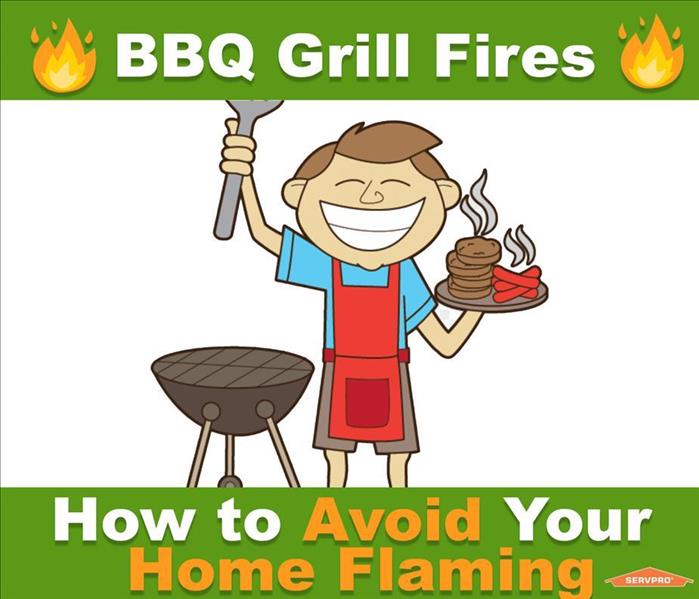 Let's Keep the Fire on the Grill
Let's Keep the Fire on the Grill
Barbeque grills are a leading cause of fires according to the National Fire Protection Association. Typically these fires are more likely to happen on balconies and porches of apartment blocks however it is also necessary to know the safety precautions if you barbeque at your home.
How Do I Avoid Starting a BBQ Fire?
- Keep the grill a minimum of 15 feet away from any over hang. This is to ensure that smoke can escape freely and also minimises the risk of any heat being trapped and potentially starting a fire.
- Store the grill a minimum of 5 feet away from all over hangs. It is most likely easiest to keep the barbeque at the same location (15 feet away).
- Someone must be at the grill at all times. Fires can happen so fast and if someone is even sitting down a few feet away, that can be enough time for the fire to get out of control.
- If it's a propane tank: never have this inside your building, home or apartment. This includes storing.
What happens if a fires breaks loose?
A common mistake people do is throw water directly onto the grill. This is more dangerous than safe. When water is thrown onto a hot grill it creates steam and this steam can cause up to third degree burns instantly. Steam is worse than fire.
For this reason it is important that you attempt to turn off the gas or electricity source immediately. This will cut the energy supply to the fire and hopefully be enough to stop the grill fire. But only do this if it is safe to do so.
Remove everyone from the area immediately. You and your families safety is the key importance.
Please Take This Seriously
We urge you to be alert and proactive with these safety precautions every time you grill your barbeque. It is hard for us to see when we have to conduct fire restoration on families homes.
We hope that you have found this helpful.
From the team at SERVPRO of Wood, Ritchie & Pleasants Counties
3 Small (Free) Tasks That Will Stop Your Christmas Tree Catching On Fire
11/25/2019 (Permalink)
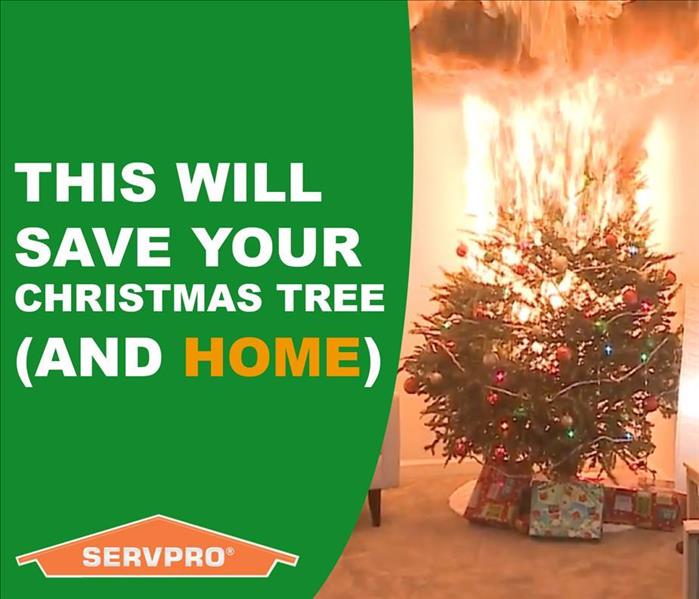 A Minute a Day Can Save You A Lot of Heartache
A Minute a Day Can Save You A Lot of Heartache
Christmas is a time of joy, yet unfortunately some families in the Parkersburg, WV area have had this time turn to heartache. This heartache was so easily avoidable that we had to share this with the community. They did not keep their Christmas tree moist. Their Christmas tree became dryer over the holiday period and therefore was more vulnerable to fire.
“These fires can grow faster than you can act. Quickly engulfing the home.”
Why Is a Christmas Tree a Fire Hazard?
As the leaves and wood becomes dryer, they become optimal fuel for fire. The fire can feed off the materials and grow. These fires can grow faster than you can act with getting water, and as the fire grows, everything else around it becomes more likely to catch alight as well. As the fire grows larger and larger, catching smaller items, the home becomes more likely to go as well.
How To Prevent Your Christmas Tree from Catching On Fire
There are three vital steps to take with your real Christmas Tree:
- Buy fresh Christmas Trees: The CPSC says “A fresh tree is green, its needles are hard to pull from branches, and its needles do not break when bent between your fingers."
- Keep the tree away from all heat sources: Do not play with fire. Literally. Keep your Christmas tree more than 5 feet away from the fireplace and 3 feet from a heater or candles. Also remember to keep your Christmas tree away from any exits and doorways.
- Water your tree daily: Do not let the leaves and wood dry. Luckily, this is very simple to do. All that you need is a spray bottle with water. Spray it every morning thoroughly to wet the leaves with a small mist over them. They will absorb the water, dramatically minimising the chance of fire.
A minute a day will save you tens of thousands of dollars in Fire Damage and a lot of heartache in a time that is meant for family.
If you wish to purchase an artificial tree be sure to check that it is fire resistant.
For more fire tips simply click here.
Enjoy your Christmas and have a joyous holiday period with your family.
From the team at SERVPRO of Wood, Ritchie & Pleasants Counties.
5 Steps to a JUICIER THANKSGIVING TURKEY Without Burning the House Down
11/17/2019 (Permalink)
 No-One Likes A Burned Turkey
No-One Likes A Burned Turkey
With Thanksgiving just around the corner, the turkeys are almost ready. But sometimes we forget about them then BAM! The turkey is now more charcoal than caramel looking.
Sure, we're not a cooking company, but we do want your Thanksgiving to go to plan and be a happy time with the family. So here's a few things we found on the internet that we've done ourselves to make Thanksgiving great.
How to Cook a Juicy Thanksgiving Turkey, Charcoal-Free
- Thaw Correctly. Don't got stuffing that turkey in the oven prematurely. You've got to let it thaw! And it takes a little longer than you think. A 20lb turkey can take up to 4 to 5 days to properly thaw in the refrigerator. So be patient. Good things take time.
- Seal Those Juices In with Oil. Coat that baby with olive oil, butter or cooking spray (we recommend olive oil). By doing this before you cook, you will be ensuring that the juices are locked in properly. Yum!
- Don't Stuff It With Stuffing. This was a new one for us. Don't go the generic route. You want to be remembered as a cooking extraordinaire right? So stuff that turkey with lemons, onions, garlic, celery or any other fragrant stuffings you can think of. Using bread will suck the juices out of the turkey, making it dryer. Another option is to cook the stuffing separately.
- Cover and leave it. A common problem our families in Parkersburg, WV were guilty of was constantly uncovering the thanksgiving turkey to baste it. This allowed the steam to escape which meant the turkey was getting dryer, rather than keeping juicy.
- Follow directions and set a timer! This is where it is important. Year after year we have been called out to remediate fire damage from a very well-done Thanksgiving Turkey and a well-done kitchen. Even if you're from Harrisville, WV, don't forget.
BONUS REMINDER: Check your smoke alarm in your kitchen. Are the batteries up to date?
Please don't forget to share this with your friends and family and have an amazing time with them during this Thanksgiving.
From the team at SERVPRO of Wood, Ritchie & Pleasants Counties.
Happy Thanksgiving!
5 Must-Dos After Fire or Smoke Damage (Knowing Now Is Better Than Knowing Later)
10/28/2019 (Permalink)
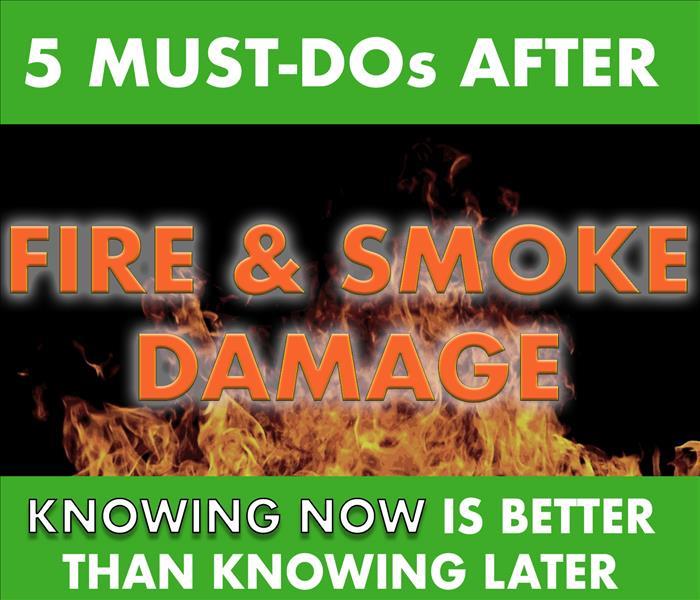 It's better to know and not need it, than to need it and not know it
It's better to know and not need it, than to need it and not know it
Fire damage to your home or business can be hard to deal with. What makes it better (or worse) is how it is dealt with after. There are some very simple steps to follow to make sure that you can minimise the effects from fire and smoke damage. Follow these below like a checklist if you're ever in this situation.
First, Lets Start with the Do's
- Limit the movement in the rooms. Too much movement from you, your family, staff or pets creates air flow. This air flow moves soot particles around the room, creating further damage to the walls, floor and furniture. If possible, close off all windows, doors and any other openings.
- Keep hands clean. Hands can transfer soot to other areas of your home or business and damage other items unnecessarily.
- Cover all upholstery, furniture etc. Keeping in mind point 1's "minimal movement", grab some linen, or cloth and cover all carpet, furniture or upholstery so that no more soot can fall onto these. IMPORTANT: Be sure to use dry towels and cloths.
- Turn off all electrical appliances. This includes the fridge, freezer, HVAC, heaters. Turn them all off to avoid further triggering fires and/or to limit air flow.
- Wipe soot off chrome in kitchen and bathroom faucets. This is important to avoid staining of the chrome. Use a slightly wet cloth when wiping down the chrome and faucets. Once completed, lightly coat these surfaces with a lubricant for greater protection.
Important things to avoid
- Do not attempt to wash the walls. While you may want to save some money on this and "do it yourself", different surfaces react differently. Some surfaces are porous and absorb soot which can further stain. It's always preferred to have a professional do this as they will have the knowledge of how to clean safely and minimising further damage.
- Do not consume any food or drink that was in proximity of the fire. This sounds obvious when we read it, but you would be surprised how in the moment, it slips your mind. Soot is sneaky. It can get in everything, underneath your packaging and lids. This contaminates your food and drink, which can lead to health issues or sickness. You’re best to throw it out.
- Do not shampoo carpet or furniture without first contacting a professional. If done incorrectly this can further embed the door or stains. Contact SERVPRO of Wood, Ritchie & Pleasants Counties first. Our team can determine the severity of the fire or smoke damage and aid you with the proper method of removal.
- Do Not turn on any ceiling fixtures. Again referencing the "Do's point 1". Turning on any ceiling fixtures will create air flow, and therefore move the soot around, furthering the issue and damage.
- Do Not attempt to clean electrical equipment. This is very important. After a fire, there is a lot of damage, particularly with electrical equipment. Damage such as fraying of wires or open circuits leave anyone who touches them vulnerable to electric shots or electrocution. Turn off all power outlets if possible but do not attempt to clean them until the SERVPRO team have assisted the situation.
We hope that this has helped. Your safety is our priority. We also are attempting to help you save money and avoid further damage in unfortunate events such as fire and smoke damage.
If this was helpful, please share it on your social media so that your friends and family can be informed.
Preparation always beats 'cure'.
- the team at SERVPRO of Wood, Ritchie & Pleasants Counties
Bonfire Tips for Wood, Ritchie & Pleasants Counties
11/1/2018 (Permalink)
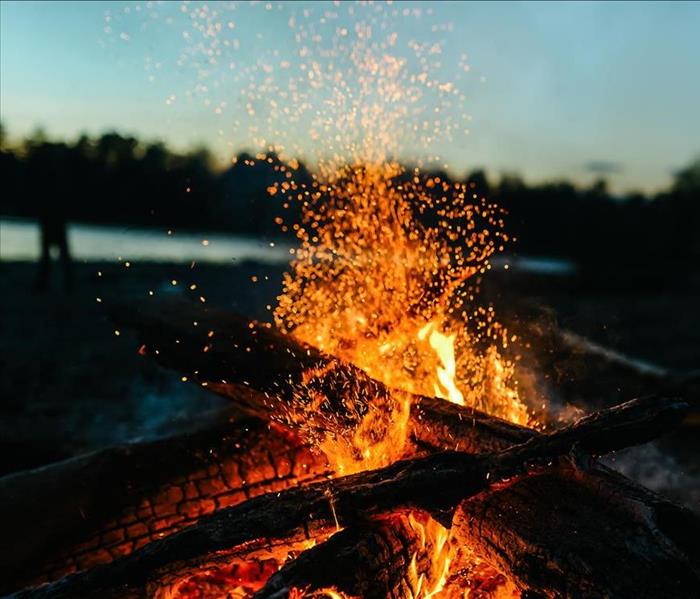 Fall is a great time to enjoy a bone fire in Wood, Ritchie & Pleasants Counties.
Fall is a great time to enjoy a bone fire in Wood, Ritchie & Pleasants Counties.
Fall is the best time of year for bonfires. If you are having a bonfire, whether it’s to get rid of garden waste or part of a celebration, follow the simple tips below to make sure you, and others, are safe.
Building a bonfireFire can spread rapidly, so where and how you build your bonfire is very important. When you have a bonfire, follow these simple guidelines:
- Give warning to your neighbors beforehand - they are much less likely to complain
- Light the bonfire at a time least likely to affect your neighbors - for example, not on a warm day when people will be in their garden
- Make sure to only burn dry material not damp, which causes more smoke
- Build the bonfire away from sheds, fences and trees
- Make sure there are no cables, like telephone wires, above the bonfire
- NEVER use petrol or paraffin to get the fire going as it may get out of control quickly
- As a rule of thumb the bonfire should be a minimum of five times its height from property
Bonfire safety tipsOnce the bonfire is lit, make sure you:
- Keep a fire extinguisher or a garden hose nearby in case of emergencies
- Never leave the bonfire unattended
- Keep children and pets away from the bonfire
- Don’t throw any fireworks into the fire
- Don't burn aerosols, tires, canisters or anything containing foam or paint - many produce toxic fumes and some containers may explode, causing injury
Once the bonfire has died down, spray the embers with water to stop it reigniting.
Christmas lights safety tips
11/1/2018 (Permalink)
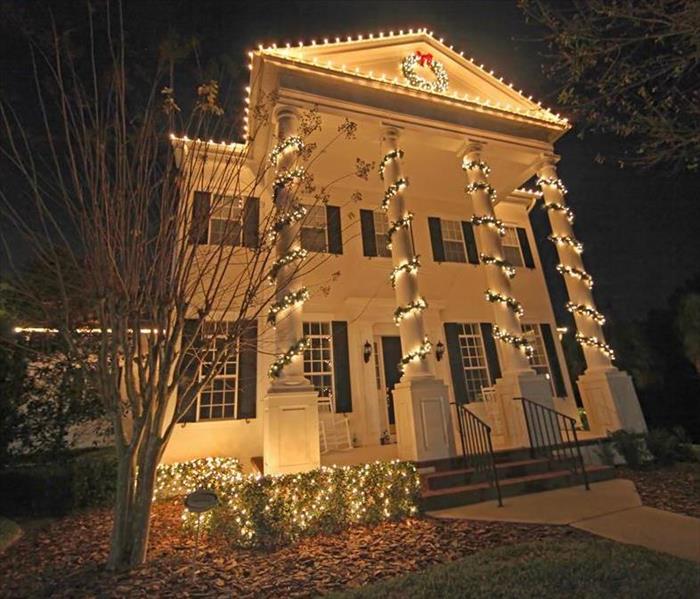 Christmas lights safety tips for your Wood, Ritchie or Pleasant County home.
Christmas lights safety tips for your Wood, Ritchie or Pleasant County home.
A MOV house lit up with Christmas lights is a beautiful sight to behold. The Mid Ohio Valley is rich with historical homes from early 1800's. But stringing lights across your roof and around your home can be a real safety hazard if you're not careful. So before you flip the switch to dazzle friends and family with your spectacular light show, take a few moments to run through a quick safety checklist. You can find them online.
? Before you string up a single strand of lights, cautiously check them for cracked cords, frayed ends or loose connections.
? The combination of shorts in electrical lights and a tinder-dry tree can be deadly. There are 250 Christmas tree fires and 14 related deaths each year, according to the U.S. Fire Administration. So always keep your tree well-watered. Not only will it stay fresh and green, but it might also keep your house from burning down.
? Modern lights have fused plugs, preventing sparks in case of a short circuit. Toss out old strands of lights that don't have fuses and get a set of newer, safer lights.
? If bulbs have burned out, replace them right away, but make sure you use the correct wattage bulbs.
? Water and debris can find its way into outdoor sockets, so always make sure outdoor lights are plugged into a ground fault circuit interrupter outlet to reduce the risk of shorts and shocks.
? Keep an eye on extension cords, as they can occasionally overheat. Just touch-test the cord. If it's hot, unplug it.
? Don't use tacks, nails or screws to hang lights, They might pierce the cable and become electrified. Try using insulated hooks instead.
? When running extension cords along the ground, make sure to elevate plugs and connectors with a brick to keep snow, water and debris out of the connections.
? Tape down any ground-level extensions cords to prevent people from tripping over them.
? Check to make sure lights have been rated by a testing laboratory. You can see a list of federally recognized labs on the Occupational Safety & Health Administration's website.
? Not all lights are rated for outdoor use. Indoor lights often have thinner insulation, which can become cracked and damaged when exposed to the elements outdoors. So make sure the ones you string up on the house belong out there.
? Never leave Christmas lights running when you go to bed at night or when you leave the house.
? When you put your lights back into storage after the holidays, be sure to put them in a well-sealed container to prevent possible water damage and to block hungry rodents looking to turn the cords into lunch. Our final advice? Be careful with ladders.
2 Types of Less Commonly Known Fire Protection Systems for Your MOV Commercial Building
10/25/2018 (Permalink)
 2 types of fire protection systems for your Wood, Ritchie & Pleasants county business.
2 types of fire protection systems for your Wood, Ritchie & Pleasants county business.
When it comes to fire protection for your commercial building, you will want to be sure you have the best possible solutions in place. By Knowing your options that are available is important. Deluge systems and pre-action systems are two less commonly known types of sprinkler systems available in commercial applications. Here’s what you need know about them.
Deluge Fire Protection Systems
Deluge systems are dry systems that have open sprinkler heads, but the pipe is not pressurized with air. The deluge system is connected to a smoke detection system. When activated it opens, and water is discharged through all the sprinkler heads.
The deluge fire protection system will use all of the available sprinkler heads in the area it is placed. That’s why these systems are best used in wide-open spaces where fires need to be flooded. Some example locations include:
- Airport hangars;
- Industrial plants;
- Transformers;
- Chemical processing plants.
Pre-Action Fire Protection Systems
Pre-action fire protection systems use both wet and dry components to control and extinguish fires. The pipes serving pre-action systems are constantly filled with highly-compressed air, but the sprinkler heads are left closed. This is the major difference between the two systems because, in the deluge systems, the sprinkler heads are left open. Until it is activated, this system is a dry one.
Once it activates, it will release water. The activation is caused when a smoke detection system identifies a fire hazard. Then once the piping fills with water, creating a wet pipe system. Lastly, the individual closed sprinkler heads over the fire will open to release water to extinguish the fire in the targeted area. Pre-action fire protection systems are commonly found in commercial buildings such as:
- Museums;
- Art galleries;
- Libraries;
- Data Centers and other data storage facilities.
Call today for a free Emergency Response Plan for your Wood, Ritchie & Pleasants county business. 304-428-7378
Fighting Fire with Science.
10/18/2018 (Permalink)
 Closing your door when you sleep can dramatically increase your chances of surviving a house fire.
Closing your door when you sleep can dramatically increase your chances of surviving a house fire.
Did you know that 40 years ago you had about 17 mins. to get out of your house during a fire?
Now you have have about 3 mins. This is due to the synthetic materials, furniture and construction materials that we use. A new consumer survey conducted by UL FSRI showed that many people keep their doors open at night and don't know that a closed door could potentially save their life in a home fire.
Fire spreads faster than ever. Having your door closed can save your life. It gives you more time to find a way out before the room fills with smoke or more time to be rescued.
Having the door closed slows down the smoke, and fire itself.
One concern that people had with having the door was that they wouldn't be able to hear the alarm. The difference, in one study, showed that there was only a 17 decimal difference between the door closed and opened. It was still loud enough to hear the alarm in the room with the door closed.
Along with the alarm, having the door closed can save your life.
Get in the habit of closing the door.
Mid Ohio Valley Smoke and Soot Cleanup
10/17/2018 (Permalink)
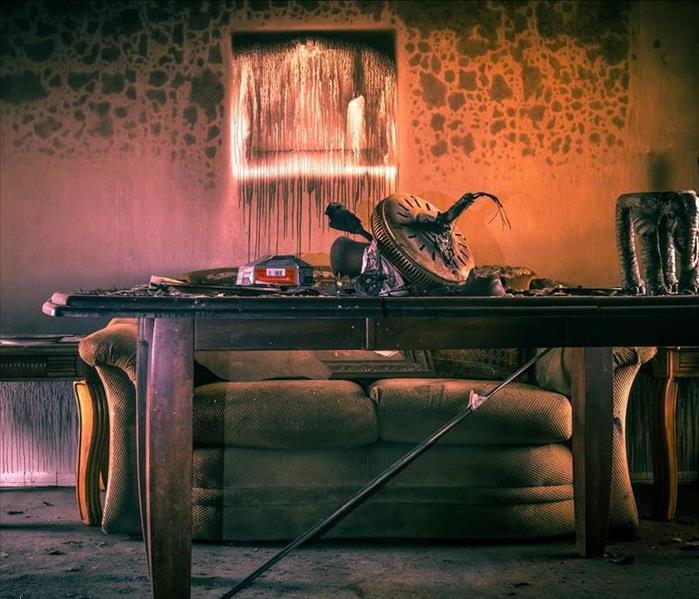 Smoke and Soot Damage Can Cause a Pervasive Odor in Your Mid Ohio Valley Home
Smoke and Soot Damage Can Cause a Pervasive Odor in Your Mid Ohio Valley Home
Smoke and soot is very invasive and can penetrate various cavities within your home, causing hidden damage and odor. Our smoke damage expertise and experience allows us to inspect and accurately assess the extent of the damage to develop a comprehensive plan of action.
Smoke and soot facts:
- Hot smoke migrates to cooler areas and upper levels of a structure.
- Smoke flows around plumbing systems, seeping through the holes used by pipes to go from floor to floor.
- The type of smoke may greatly affect the restoration process.
Different Types of Smoke
There are two different types of smoke–wet and dry. As a result, there are different types of soot residue after a fire. Before restoration begins, SERVPRO of Wood, Ritchie, & Pleasants Counties will test the soot to determine which type of smoke damage occurred. The cleaning procedures will then be based on the information identified during pretesting. Here is some additional information:
Wet Smoke – Plastic and Rubber
- Low heat, smoldering, pungent odor, sticky, smeary. Smoke webs are more difficult to clean.
Dry Smoke – Paper and Wood
- Fast burning, high temperatures, heat rises therefore smoke rises.
Protein Fire Residue – Produced by evaporation of material rather than from a fire
- Virtually invisible, discolors paints and varnishes, extreme pungent odor.
Our Fire Damage Restoration Services
Since each smoke and fire damage situation is a little different, each one requires a unique solution tailored for the specific conditions. We have the equipment, expertise, and experience to restore your fire and smoke damage. We will also treat your family with empathy and respect and your property with care.
Have Questions about Fire, Smoke, or Soot Damage?
Call Us Today 304-428-7378





 24/7 Emergency Service
24/7 Emergency Service







